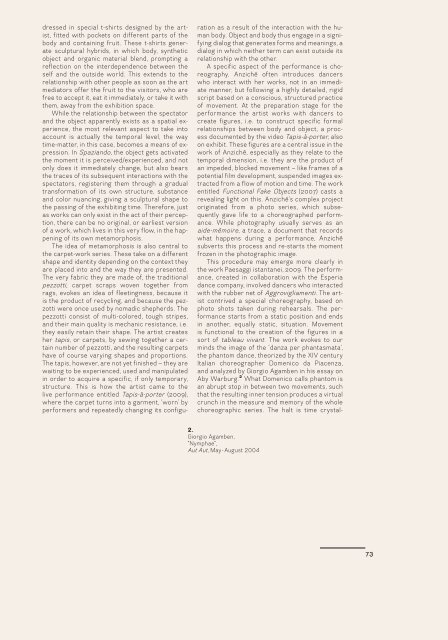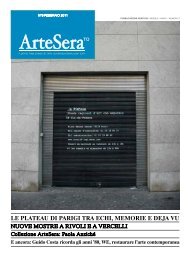Download Catalogue - Paola Anziché
Download Catalogue - Paola Anziché
Download Catalogue - Paola Anziché
You also want an ePaper? Increase the reach of your titles
YUMPU automatically turns print PDFs into web optimized ePapers that Google loves.
dressed in special t-shirts designed by the artist,<br />
fitted with pockets on different parts of the<br />
body and containing fruit. These t-shirts generate<br />
sculptural hybrids, in which body, synthetic<br />
object and organic material blend, prompting a<br />
reflection on the interdependence between the<br />
self and the outside world. This extends to the<br />
relationship with other people as soon as the art<br />
mediators offer the fruit to the visitors, who are<br />
free to accept it, eat it immediately, or take it with<br />
them, away from the exhibition space.<br />
While the relationship between the spectator<br />
and the object apparently exists as a spatial experience,<br />
the most relevant aspect to take into<br />
account is actually the temporal level, the way<br />
time-matter, in this case, becomes a means of expression.<br />
In Spaziando, the object gets activated<br />
the moment it is perceived/experienced, and not<br />
only does it immediately change, but also bears<br />
the traces of its subsequent interactions with the<br />
spectators, registering them through a gradual<br />
transformation of its own structure, substance<br />
and color nuancing, giving a sculptural shape to<br />
the passing of the exhibiting time. Therefore, just<br />
as works can only exist in the act of their perception,<br />
there can be no original, or earliest version<br />
of a work, which lives in this very flow, in the happening<br />
of its own metamorphosis.<br />
The idea of metamorphosis is also central to<br />
the carpet-work series. These take on a different<br />
shape and identity depending on the context they<br />
are placed into and the way they are presented.<br />
The very fabric they are made of, the traditional<br />
pezzotti, carpet scraps woven together from<br />
rags, evokes an idea of fleetingness, because it<br />
is the product of recycling, and because the pezzotti<br />
were once used by nomadic shepherds. The<br />
pezzotti consist of multi-colored, tough stripes,<br />
and their main quality is mechanic resistance, i.e.<br />
they easily retain their shape. The artist creates<br />
her tapis, or carpets, by sewing together a certain<br />
number of pezzotti, and the resulting carpets<br />
have of course varying shapes and proportions.<br />
The tapis, however, are not yet finished – they are<br />
waiting to be experienced, used and manipulated<br />
in order to acquire a specific, if only temporary,<br />
structure. This is how the artist came to the<br />
live performance entitled Tapis-à-porter (2009),<br />
where the carpet turns into a garment, ‘worn’ by<br />
performers and repeatedly changing its configu-<br />
ration as a result of the interaction with the human<br />
body. Object and body thus engage in a signifying<br />
dialog that generates forms and meanings, a<br />
dialog in which neither term can exist outside its<br />
relationship with the other.<br />
A specific aspect of the performance is choreography.<br />
<strong>Anziché</strong> often introduces dancers<br />
who interact with her works, not in an immediate<br />
manner, but following a highly detailed, rigid<br />
script based on a conscious, structured practice<br />
of movement. At the preparation stage for the<br />
performance the artist works with dancers to<br />
create figures, i.e. to construct specific formal<br />
relationships between body and object, a process<br />
documented by the video Tapis-à-porter, also<br />
on exhibit. These figures are a central issue in the<br />
work of <strong>Anziché</strong>, especially as they relate to the<br />
temporal dimension, i.e. they are the product of<br />
an impeded, blocked movement – like frames of a<br />
potential film development, suspended images extracted<br />
from a flow of motion and time. The work<br />
entitled Functional Fake Objects (2007) casts a<br />
revealing light on this. <strong>Anziché</strong>’s complex project<br />
originated from a photo series, which subsequently<br />
gave life to a choreographed performance.<br />
While photography usually serves as an<br />
aide-mémoire, a trace, a document that records<br />
what happens during a performance, <strong>Anziché</strong><br />
subverts this process and re-starts the moment<br />
frozen in the photographic image.<br />
This procedure may emerge more clearly in<br />
the work Paesaggi istantanei, 2009. The performance,<br />
created in collaboration with the Esperia<br />
dance company, involved dancers who interacted<br />
with the rubber net of Aggrovigliamenti. The artist<br />
contrived a special choreography, based on<br />
photo shots taken during rehearsals. The performance<br />
starts from a static position and ends<br />
in another, equally static, situation. Movement<br />
is functional to the creation of the figures in a<br />
sort of tableau vivant. The work evokes to our<br />
minds the image of the ‘danza per phantasmata’,<br />
the phantom dance, theorized by the XIV century<br />
Italian choreographer Domenico da Piacenza,<br />
and analyzed by Giorgio Agamben in his essay on<br />
Aby Warburg. 2 What Domenico calls phantom is<br />
an abrupt stop in between two movements, such<br />
that the resulting inner tension produces a virtual<br />
crunch in the measure and memory of the whole<br />
choreographic series. The halt is time crystal-<br />
2.<br />
Giorgio Agamben,<br />
“Nymphae”,<br />
Aut Aut, May - August 2004<br />
73



